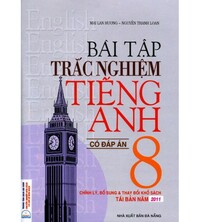Tiếng Anh 8 Unit 2 2.7 Writing
1. In groups, look at the picture. What natural disasters are they? Put the words and phrases in the right box under each picture. Some words and phrases can go into more than one box. 2. In groups, read the sample writing and complete the table below. 3. Put the following ideas in the correct column. Some sentences can go into more than one place. 4. In groups, write a paragraph (80-100 words) to report a natural disaster you know well or have experienced yo your teachers and friends.
Bài 1
1. In groups, look at the picture. What natural disasters are they? Put the words and phrases in the right box under each picture. Some words and phrases can go into more than one box.
(Theo nhóm, nhìn vào bức tranh. Đó là những thiên tai nào? Đặt các từ và cụm từ vào ô bên phải dưới mỗi bức tranh. Một số từ và cụm từ có thể đi vào nhiều ô.)
|
a. tropical storm (bão nhiệt đới) b. epicenter (tâm chấn) c. shaking (rung lắc) d. floods (lũ lụt) e. strong winds (gió to) |
f. collapse (sụp đổ) g. badly injured (bị thương nặng) h. water shortage (thiếu nước) i. low rainfall (lượng mưa thấp) k. damage to buildings and houses (thiệt hại cho các tòa nhà và nhà cửa.) |

Lời giải chi tiết:
Picture 1: water shortage, low rainfall.
(Tranh 1: thiếu nước, lượng mưa ít.)
Picture 2: tropical storm, strong winds.
(Tranh 2: bão nhiệt đới, gió mạnh.)
Picture 3: epicenter, shaking, collapse, damage to building and houses, badly injured.
(Tranh 3: tâm chấn, rung lắc, đổ sập, nhà cửa hư hỏng, bị thương nặng.)
Picture 4: floods, damage to buildings and houses.
(Tranh 4: lũ lụt, nhà cửa bị hư hại.)
Bài 2
2. In groups, read the sample writing and complete the table below.
(Theo nhóm, đọc bài viết mẫu và hoàn thành bảng dưới đây.)
A severe drought took place this summer in the Mekong Delta region. The rainy season arrived late last year and was shorter than usual. The rainfall was 8 percent lower than normal at 1,240 mm. The drought had severe effects on people’s lives. The rice crop died due to the shortage of water. Farmers lost their jobs and had to leave the countryside to work in the cities. Many people had to buy water for daily use at a very high price. To overcome this situation, hundreds of volunteers brought water tanks to help affected people in the drought areas.
|
What is the natural disaster? |
|
|
What happened? |
|
|
Where and when did it happen? |
|
|
What are the effects of this disaster? |
|
|
What have been done to help the victims of the disaster? |
|
Phương pháp giải:
Tạm dịch:
Một đợt hạn hán nghiêm trọng đã diễn ra vào mùa hè năm nay ở khu vực đồng bằng sông Cửu Long. Mùa mưa năm ngoái đến muộn và ngắn hơn mọi năm. Lượng mưa thấp hơn 8% so với bình thường ở mức 1.240 mm. Hạn hán đã ảnh hưởng nghiêm trọng đến cuộc sống của người dân. Lúa bị chết do thiếu nước. Nông dân bị mất việc làm và phải rời nông thôn để làm việc ở các thành phố. Nhiều người dân đã phải mua nước sinh hoạt với giá rất cao. Để khắc phục tình trạng này, hàng trăm tình nguyện viên đã mang thùng nước đến giúp người dân vùng hạn hán bị ảnh hưởng.
Lời giải chi tiết:
|
What is the natural disaster? (Thảm họa thiên nhiên là gì?) |
A severe drought (Một đợt hạn hán nghiêm trọng) |
|
What happened? (Chuyện gì đã xảy ra?) |
The rainy season arrived late last year and was shorter than usual. The rainfall was 8 percent lower than normal at 1,240 mm. (Mùa mưa năm ngoái đến muộn và ngắn hơn mọi năm. Lượng mưa thấp hơn 8% so với bình thường ở mức 1.240 mm.) |
|
Where and when did it happen (Nó xảy ra ở đâu và khi nào?) |
A severe drought took place this summer in the Mekong Delta region (Một đợt hạn hán nghiêm trọng đã diễn ra vào mùa hè năm nay ở khu vực đồng bằng sông Cửu Long.) |
|
What are the effects of this disaster? (Những ảnh hưởng của thảm họa này là gì?) |
The drought had severe effects on people’s lives. The rice crop died due to the shortage of water. Farmers lost their jobs and had to leave the countryside to work in the cities. Many people had to buy water for daily use at a very high price. (Hạn hán đã ảnh hưởng nghiêm trọng đến cuộc sống của người dân. Lúa bị chết do thiếu nước. Nông dân bị mất việc làm và phải rời nông thôn để làm việc ở các thành phố. Nhiều người dân đã phải mua nước sinh hoạt với giá rất cao.) |
|
What have been done to help the victims of the disaster? (Những gì đã được thực hiện để giúp đỡ các nạn nhân của thảm họa?) |
To overcome this situation, hundreds of volunteers brought water tanks to help affected people in the drought areas. (Để khắc phục tình trạng này, hàng trăm tình nguyện viên đã mang thùng nước đến giúp người dân vùng hạn hán bị ảnh hưởng.) |
Bài 3
3. Put the following ideas in the correct column. Some sentences can go into more than one place.
(Đặt những ý tưởng sau đây trong cột đúng. Một số câu có thể đi vào nhiều hơn một nơi.)
|
|
Earthquake |
Typhoon |
|
What happened? |
|
|
|
Where and when did it happen? |
|
|
|
What are the effects of this disaster? |
|
|
|
What have been done to help the victims of the disaster? |
|
|
1. Many people lost their homes.
(Nhiều người mất nhà cửa.)
2. Many people tried to cover their heads and hide under heavy furniture such as tables and beds.
(Nhiều người cố gắng che đầu và trốn dưới đồ nội thất nặng như bàn và giường.)
3. Rescue workers came to help local people.
(Nhân viên cứu hộ đến giúp đỡ người dân địa phương.)
4. Buildings in the epicentre area with weak walls experienced cracks and some houses collapsed.
(Các tòa nhà ở khu vực tâm chấn có tường yếu bị nứt và một số ngôi nhà bị sập.)
5. People could clearly feel a strong shaking.
(Mọi người có thể cảm nhận rõ ràng sự rung lắc mạnh.)
6. It hit the central Việt Nam as one of the biggest storms in the last two decades.
(Đổ bộ vào miền Trung Việt Nam là một trong những cơn bão lớn nhất trong hai thập kỷ qua.)
Lời giải chi tiết:
|
|
Earthquake (Động đất) |
Typhoon (Bão nhiệt đới) |
|
What happened? (Chuyện gì đã xảy ra thế?) |
Many people lost their homes. (Nhiều người mất nhà cửa.) |
Many people lost their homes. (Nhiều người mất nhà cửa.) |
|
Where and when did it happen? (Nó xảy ra ở đâu và khi nào?) |
|
It hit the central Việt Nam as one of the biggest storms in the last two decades. (Đổ bộ vào miền Trung Việt Nam là một trong những cơn bão lớn nhất trong hai thập kỷ qua.) |
|
What are the effects of this disaster? (Những ảnh hưởng của thảm họa này là gì?) |
- Buildings in the epicentre area with weak walls experienced cracks and some houses collapsed. (Các tòa nhà ở khu vực tâm chấn có tường yếu bị nứt và một số ngôi nhà bị sập.) - People could clearly feel a strong shaking. (Mọi người có thể cảm nhận rõ ràng sự rung lắc mạnh.) - Many people tried to cover their heads and hide under heavy furniture such as tables and beds. (Nhiều người cố gắng che đầu và trốn dưới đồ nội thất nặng như bàn và giường.) |
- Buildings in the epicentre area with weak walls experienced cracks and some houses collapsed. (Các tòa nhà ở khu vực tâm chấn có tường yếu bị nứt và một số ngôi nhà bị sập.)
|
|
What have been done to help the victims of the disaster? (Những gì đã được thực hiện để giúp đỡ các nạn nhân của thảm họa?) |
- Rescue workers came to help local people. (Nhân viên cứu hộ đến giúp đỡ người dân địa phương.) |
- Rescue workers came to help local people. (Nhân viên cứu hộ đến giúp đỡ người dân địa phương.) |
Bài 4
4. In groups, write a paragraph (80-100 words) to report a natural disaster you know well or have experienced yo your teachers and friends.
(Theo nhóm, viết một đoạn văn (80-100 từ) để báo cáo một thảm họa thiên nhiên mà bạn biết rõ hoặc đã trải qua với thầy cô và bạn bè của bạn.)
Lời giải chi tiết:
Natural disasters are one of the biggest problems that people have to face to face nowadays. So does Vietnam, we are against natural disasters. The most common natural disasters in Vietnam are hurricanes. The hurricanes can cause damage to houses and peoples. A lot of people lost homes so they don’t have a place to live in. Not only that, they also suffer the pain of losing their relatives. According to statistics, the hurricanes in Vietnam made about 230 people die and a lot of people can’t be found. What is more dangerous than it causes the flood. Flooding is also a dangerous natural disaster because it can cause harm like a hurricane... Additionally, it can make the water line polluted and this is one of the causes that make people and animals sick. From these arguments, we can know about the harmfulness of hurricanes and floods so I will tell you some ways to prevent the hurricanes and floods. First, you should always update the news about the hurricanes. Second, you should prepare essential things such as water, food, clothes, medicines, first-aid-kits,...Third, we should reinforce our house and always be ready to evacuate. In conclusion, I can say that natural disasters are extremely dangerous, but we can prevent them by doing what I say.
Tạm dịch:
Thiên tai là một trong những vấn đề lớn nhất mà con người phải đối mặt hiện nay. Việt Nam cũng vậy, chúng ta chống thiên tai. Thiên tai phổ biến nhất ở Việt Nam là bão. Các cơn bão có thể gây thiệt hại cho nhà cửa và người dân. Nhiều người mất nhà cửa không chốn dung thân. Không chỉ vậy, họ còn phải gánh chịu nỗi đau mất đi người thân. Theo thống kê, các trận cuồng phong ở Việt Nam đã làm khoảng 230 người chết và rất nhiều người chưa thể tìm thấy. Nguy hiểm hơn là nó gây ra lũ lụt. Lũ lụt cũng là một thiên tai nguy hiểm vì nó có thể gây tác hại như một trận cuồng phong... Ngoài ra, nó còn có thể làm cho dòng nước bị ô nhiễm và đây là một trong những nguyên nhân gây bệnh cho con người và động vật. Từ những lập luận đó, chúng ta có thể biết về tác hại của bão và lũ lụt, vì vậy tôi sẽ cho bạn biết một số cách để ngăn chặn cơn bão và lũ lụt. Đầu tiên, bạn phải luôn cập nhật tin tức về các cơn bão. Thứ hai, bạn nên chuẩn bị những thứ cần thiết như nước, thực phẩm, quần áo, thuốc men, hộp sơ cứu,... Thứ ba, chúng ta nên gia cố nhà cửa và luôn sẵn sàng sơ tán. Tóm lại, tôi có thể nói rằng thiên tai là cực kỳ nguy hiểm, nhưng chúng ta có thể ngăn chặn chúng bằng cách làm theo những gì tôi nói.
Search google: "từ khóa + timdapan.com" Ví dụ: "Tiếng Anh 8 Unit 2 2.7 Writing timdapan.com"







